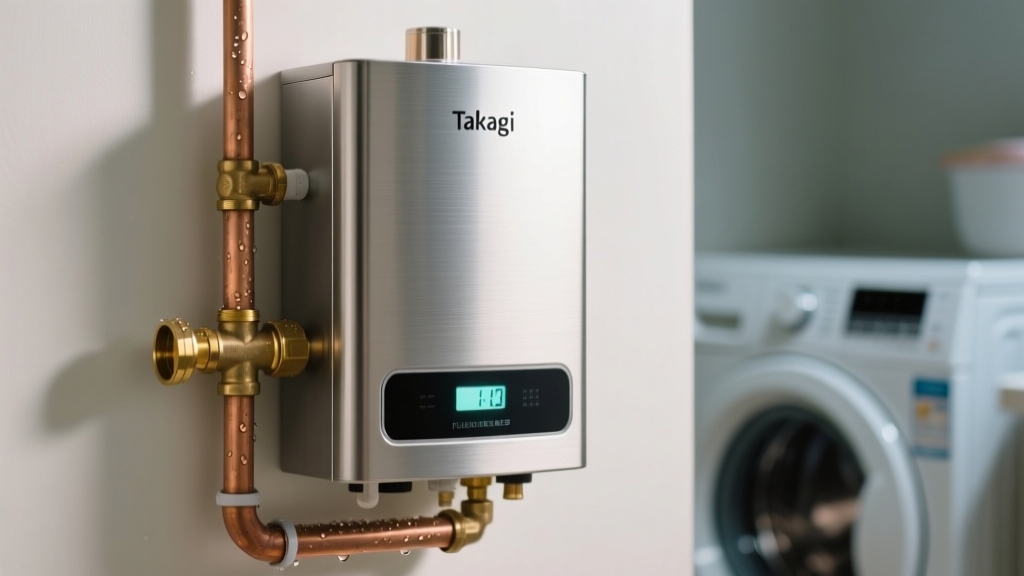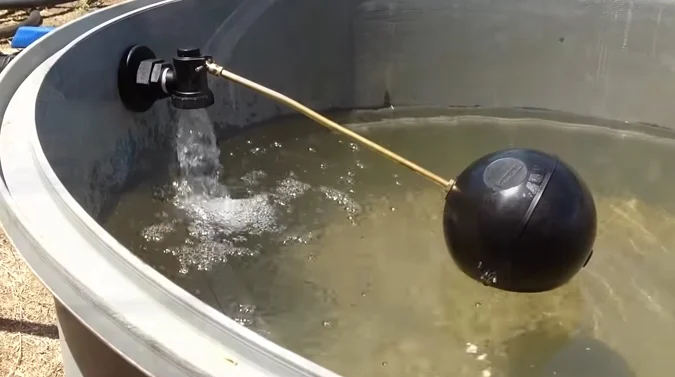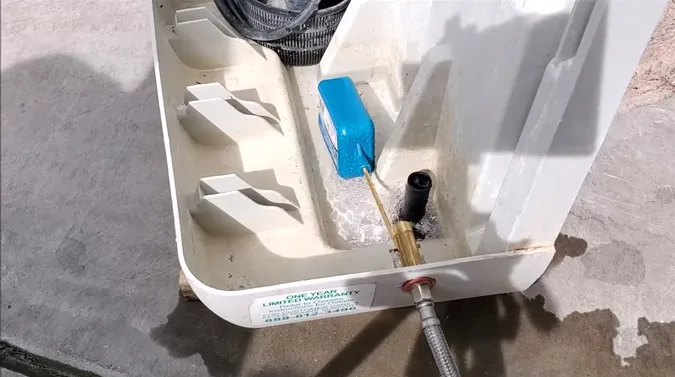If you choose a Takagi tankless water heater, you’ll get reliable, energy-efficient performance with flexible installation options and advanced safety features. Their models suit both homes and businesses, offering strong flow rates and precise temperature control.
You’ll appreciate durable copper heat exchangers and eco-friendly, low-emission technology. Services vary by model but generally provide solid coverage, while user-friendly diagnostics help you maintain peak operation.
Exploring further reveals how these benefits fit your specific needs and setup.
- Endless hot water, On-demand usage, Compact, Space saving, Energy conservation
- Computerized safety features, No pilot light to have to worry about
- Safety features include freeze, overheat, surge protection, and troubleshooting diagnostic codes
Key Takeaways
- Takagi tankless water heaters offer high flow rates up to 10 GPM with efficient, space-saving designs suitable for residential and commercial use.
- Models feature advanced technologies like X3® Scale Prevention and ultra-low NOx emissions, ensuring durability and environmental compliance.
- Installation supports flexible venting options and compact mounting, but requires adherence to safety codes and proper gas compatibility.
- User-friendly diagnostics and remote controls simplify maintenance and fault detection, aiding in quick troubleshooting and long-term reliability.
Overview of Takagi Tankless Water Heater Models
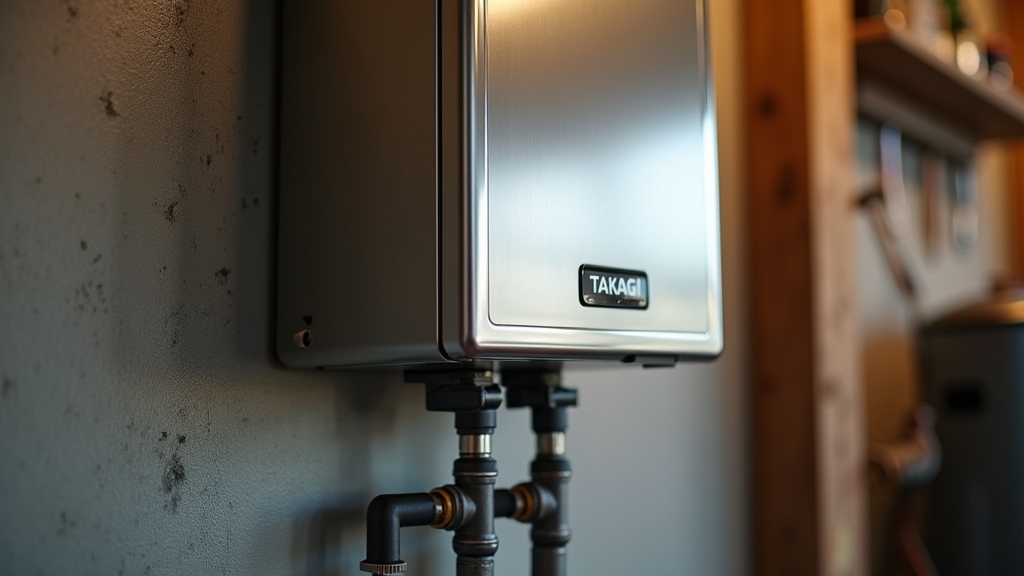
Although Takagi offers a wide range of tankless water heaters, you’ll find models tailored specifically for residential, commercial, and hybrid applications to meet diverse hot water demands. Takagi’s tankless water heaters are designed to suit residential, commercial, and hybrid needs for reliable hot water.
Residential models like the TK-110U-I deliver 6.6 GPM at 140,000 BTU, fitting typical household use. The TK-510U-I/E provides up to 10 GPM and 199,000 BTU for larger needs. Ensuring proper installation can help avoid issues commonly associated with unsealed entry points.
Commercial and hybrid units, such as the T-H3 series, cover flow rates of 6.6 to 8 GPM with BTUs between 120,000 and 190,000, suitable for intensive or mixed applications. You can choose between natural gas or liquid propane fuel, with indoor or outdoor installation options.
This flexibility, combined with energy-efficient certifications, guarantees you find a model matching your specific usage and space requirements. Many units also feature Ultra-Low Nox emissions technology, enhancing environmental compliance and safety.
Key Features and Technology Highlights
Takagi tankless water heaters offer several key features and advanced technologies designed to enhance your hot water experience while guaranteeing efficiency and durability.
Their compact, wall-mountable design saves space, and you’ll enjoy endless hot water even with multiple appliances running. The pure copper heat exchangers enable rapid heat transfer, while precise temperature controls let you set consistent water temperatures.
This system activates heating only when hot water is needed, significantly reducing energy waste due to standby losses. Regular maintenance is essential for preventing mineral scale buildup, which can impair performance. You can install these units indoors or outdoors, providing flexibility.
Technology highlights include Ultra-Low NOx condensing models that reduce emissions, commercial-grade copper alloy tubing for durability, and X3® Scale Prevention Technology, which triples heater lifespan by preventing scale buildup.
Safety features like flame sensors and overheat protection ensure secure operation, making Takagi heaters a reliable and advanced choice for your home or business. Ensuring a stable power supply is also critical for consistent performance and pressure in connected systems.
Energy Efficiency and Environmental Benefits
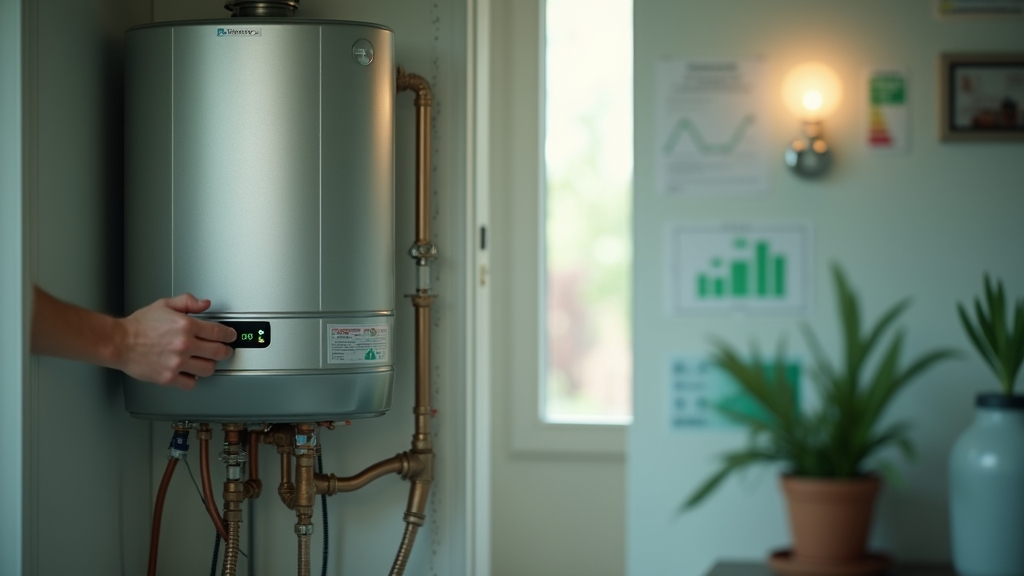
Hey there! You’re really going to love how Takagi’s use of condensing technology cranks up energy efficiency. It actually extracts more heat from those combustion gases, which is pretty cool, right? This technology also helps in reducing hot water consumption, making your home even more energy-efficient.
And guess what? Their models are ENERGY STAR certified! That means you can save energy without giving up on performance. How great is that? Plus, let’s not forget about the ultra-low NOx emissions. Choosing one of these water heaters is a win-win for both your home and the environment. It’s a smart choice all around!
In addition, the compact design of Takagi tankless water heaters allows them to fit easily into tight spaces, making them ideal for homes with limited installation areas.
Ultra-Low NOx Emissions
Because ultra-low NOx emissions directly influence both energy efficiency and environmental health, choosing a water heater that meets stringent standards can substantially benefit you.
Takagi models comply with strict regulations like South Coast AQMD, limiting nitrogen oxide emissions to below 14 ng/J or 20 ppm. This reduces smog formation and respiratory risks, enhancing air quality especially in urban areas. Proper maintenance, including disassembly procedures, ensures the heater operates at peak environmental performance.
Efficient combustion and superior copper alloy heat exchangers further optimize fuel use, lowering emissions and operational costs. The heater’s copper heat exchanger ensures temperature stability and reduces pressure drop, contributing to overall system efficiency.
Key benefits include:
- Compliance with low NOx standards for cleaner air
- Reduced respiratory and cardiovascular health risks
- Enhanced energy utilization via advanced heat exchangers
- Support for sustainable building practices and regulatory mandates
ENERGY STAR Certification
Meeting ultra-low NOx emissions standards sets a solid foundation for cleaner air. Energy efficiency plays an equally important role in reducing your environmental impact and operating costs. If you ever need to perform maintenance, knowing how to turn off water under sink without valve can be crucial.
Takagi’s Energy Star certified tankless water heaters boast Uniform Energy Factors (UEF) of 0.82 or higher. Top models like the TK-540P-NIH reach 0.95. This efficiency means you’ll use less natural gas or propane, lowering greenhouse gas emissions and utility bills.
Plus, these models qualify for federal tax credits and rebates, which can considerably offset initial costs. Federal tax credits can reach up to $600 for high-efficiency models. Features like commercial-grade copper alloy heat exchangers and modulating gas systems optimize fuel use and durability.
Condensing Technology Efficiency
Although condensing technology may seem complex, it delivers remarkable energy efficiency and environmental benefits that directly impact your utility costs and carbon footprint.
Takagi’s condensing tankless water heaters achieve a Uniform Energy Factor up to 0.95 by recovering heat from exhaust gases through a secondary heat exchanger, reducing wasted energy. Their Ultra-Low NOx combustion technology lowers harmful emissions, while electronic ignition eliminates standby energy loss, improving fuel economy.
They also operate on demand, heating water only when needed, which eliminates standby heat loss and further reduces energy costs demand operation. Additionally, their compact design supports flexible installation options, similar to space-saving upflush toilet systems.
Durable materials like commercial-grade copper and stainless steel ensure sustained efficiency and longevity. Key benefits include:
- Up to 94-95% energy efficiency, greatly reducing fuel consumption
- Significant NOx emissions reduction, meeting strict environmental standards
- Scale prevention technology to maintain performance over time
- Compact, space-saving design minimizing environmental impact during installation
Performance and Flow Rate Analysis
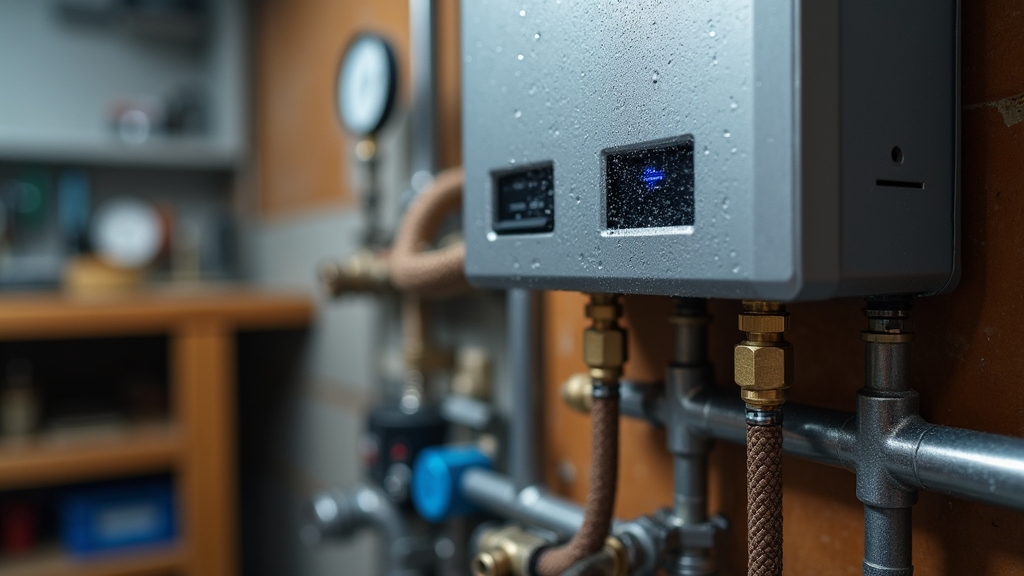
When selecting a Takagi tankless water heater, understanding its performance and flow rate is essential to match your household’s hot water demands.
Popular models offer maximum flow rates between 6.6 and 10 GPM, with the TK-540X3-NIH delivering up to 10 GPM at 199,000 BTU/hour. This capacity aligns well with other top brands that support multiple fixtures simultaneously through advanced condensing technology.
Flow rate decreases as the required temperature rise increases; for example, at a 30°F rise, flow peaks near 10 GPM, but it drops at higher rises like 45°F. Higher BTU inputs correlate with higher flow capacity, while modulating burners adjust output to optimize efficiency.
Most models fall within the 0-49 lbs weight category, making installation and handling more manageable. Climate impacts performance, as colder groundwater requires more temperature rise, reducing flow. Takagi units maintain stable, continuous flow through advanced sensors and modulation, ensuring consistent hot water without lag or pressure loss.
- Never run out of water again with a steady 6.6 GPM flow rate
- Electric ignition ensures you never have to mess with a pilot light again
- Uniform Energy Factor of 0.93
Installation Options and Compatibility
When it comes to installing Takagi tankless water heaters, you’ll notice they offer a lot of flexibility with their mounting options. Typically, you’ll need to securely install them on a wall, making sure they’re properly supported for stability. Proper placement also helps in managing heat dissipation effectively to avoid overheating issues.
When you’re picking a spot for your heater, think about how easy it will be to access, as well as the existing plumbing and how close the gas line is. This will help ensure everything is compatible. It is also important to locate the gas line entry point and adhere to the National Fuel Gas Code and manufacturer recommendations.
Now, here’s something cool: these units can accommodate both horizontal and vertical venting. This means they can fit into various setups depending on your building’s specific needs for fuel types and combustion air supply.
Mounting and Location Flexibility
Since space and ventilation can vary widely in homes, Takagi tankless water heaters offer versatile mounting and location options to fit your specific needs. You can install units vertically or horizontally, even in tight spaces like closets or utility rooms.
Many installation scenarios benefit from incorporating air admittance valves to manage venting in confined areas effectively. For safety and maximum function, the heater must be level and securely mounted, often using an OSB backing board to align brackets.
Location planning ensures compliance with local codes and proper combustion air supply. Depending on the installation type, you may need to select appropriate venting components such as category III stainless steel venting for indoor or outdoor use.
Key points to contemplate include:
- Vertical or horizontal mounting flexibility
- Small footprint ideal for confined spaces
- Requirement for level and plumb installation
- Use of backing boards and secure anchors for stability
Venting and Fuel Compatibility
Mounting your Takagi tankless water heater in the right spot is only part of the installation story. Venting and fuel compatibility play a significant role in its performance and safety.
You’ll find condensing models require PVC venting and direct vent setups, while others use stainless steel vents. Proper sizing, clearances, and use of wall thimbles keep installation safe and efficient. Maintain at least 6 inches clearance from combustible materials when using single-wall vent pipes to comply with safety standards.
Using corrosion-resistant materials in venting can help ensure long-term durability and prevent leaks. Fuel compatibility depends on model variations supporting natural gas or propane. Here’s a quick guide:
| Feature | Venting Requirement | Fuel Compatibility |
|---|---|---|
| Condensing Models | PVC, direct vent only | NG & LP |
| Non-Condensing Models | Stainless steel, common venting | NG & LP |
| Vent Clearances | Comply with UL 1738 & Nat. Gas Code | N/A |
| Combustion Air Supply | Sealed 3″ or 4″ pipe required | N/A |
Venting and Safety Considerations
When selecting and installing a venting system for your Takagi tankless water heater, understanding the differences between direct venting and atmospheric venting is crucial for safety and efficiency.
Direct venting uses sealed intake and exhaust pipes, improving energy efficiency and reducing backdraft risks. It’s ideal for indoor or confined spaces. Direct vent systems prevent reliance on indoor air for combustion, enhancing indoor air quality and safety.
Direct venting seals intake and exhaust pipes, enhancing energy efficiency and minimizing backdraft risks in indoor spaces. Atmospheric venting, drawing air from surroundings, suits outdoor or well-ventilated areas but is less efficient and riskier.
Keep these venting and safety tips in mind:
- Use stainless steel Category III venting for durability, except for certain condensing models using PVC or polypropylene.
- Maintain minimum clearances to combustible materials to prevent heat damage.
- Follow local codes and UL 1738 standards to ensure safe installation.
- Avoid insulating non-metallic vent pipes to prevent fire hazards and obstruction.
Commercial vs Residential Applications
Because commercial and residential applications demand different performance levels, Takagi designs its tankless water heaters with distinct engineering and build qualities.
When choosing between the two, consider your specific hot water needs and installation context. Commercial units are built for heavy-duty use in places like hotels and restaurants, while residential models fit single homes or small multi-family setups.
Key differences include:
Commercial heaters use industrial-grade materials and larger heat exchangers for durability and longevity. They are also engineered to handle millions of thermal cycles, ensuring long-term reliability. Residential units prioritize compact, space-saving designs suitable for wall mounting.
Commercial models offer higher flow rates (up to 10 GPM) and advanced safety features for continuous operation. Residential units provide energy-efficient, modulating heating optimized for household demand. Selecting the right model guarantees efficiency, reliability, and compliance with usage demands.
Scalability and Multi-Unit Configurations
Choosing the right Takagi water heater involves more than just picking between commercial and residential models; you also need to contemplate how your system can grow with your hot water demands.
Takagi’s multi-unit controllers let you link up to 20 units (models 510U, 510C, 540, 710) or 10 units of the 910 model, with automatic unit numbering and centralized control. This setup requires the use of a Multi-Unit System Controller to manage the connected units effectively.
The T-K3 supports up to 4 linked units without a controller, but can’t connect with other models. This modular scalability means you can expand capacity incrementally, avoiding oversizing and ensuring efficient load balancing.
| Model | Max Units per Controller | Multi-System Support | Compatibility |
|---|---|---|---|
| 510U/510C | 20 | Yes | Compatible with 540,710 |
| 910 (T-M50) | 10 | Yes | Only same model |
| T-K3 | 4 | Yes (no controller) | Standalone only |
| 540/710 | 20 | Yes | Compatible with 510U/C |
Maintenance and Diagnostic Tools
With the remote control, you can easily check the status of your Takagi water heater and quickly access any fault codes. This handy feature allows you to spot potential issues early on, helping you determine if maintenance is necessary.
But that’s not all! The built-in maintenance alerts ensure you stay informed about any required services, so your heater can keep running at its best. Regular maintenance significantly enhances energy efficiency and prevents costly repairs.
Remote Control Diagnostics
When managing your Takagi tankless water heater, remote control diagnostics play a crucial role in simplifying maintenance and troubleshooting. Using compatible remotes like the TM-RE40 or TM-RE42, you can adjust temperatures between 100°F and 160°F while accessing diagnostic codes that pinpoint issues. These controllers are designed specifically for commercial tankless applications requiring higher outlet temperatures.
These codes help you identify communication errors, sensor problems, or valve malfunctions quickly, reducing downtime. You can also enter diagnostics mode for detailed system checks, ensuring accurate troubleshooting tailored to your specific model.
Key benefits of remote control diagnostics include:
- Precise temperature adjustments without manual settings
- Clear error code display for swift issue identification
- Ability to monitor communication between multiple units
- Simplified maintenance through targeted component checks
Fault Code Accessibility
How can you quickly identify and address issues with your Takagi tankless water heater? The unit’s fault code accessibility plays a vital role. Error codes appear on digital display panels or connected controllers, showing specific alphanumeric codes tied to problems like ignition failure, low water flow, or clogged filters.
You can find detailed explanations and troubleshooting steps in the user manual, helping you self-diagnose common faults. Multi System and Temperature Remote Controllers even let you view errors remotely, streamlining diagnostics without opening the unit.
Some models add LED or audible alerts for easier fault recognition. While you can access codes easily, clearing faults or resets require direct unit interaction. This system efficiently guides you to the issue’s source, enabling prompt maintenance or professional support when needed.
Additionally, checking the water flow is a crucial initial step since inadequate flow can often lead to error codes related to heating performance.
Maintenance Alerts System
Although Takagi tankless water heaters operate efficiently, their built-in maintenance alert system plays a crucial role in keeping performance ideal and preventing costly damage. This computerized diagnostic system monitors key parts like gas valves, fans, and flame sensors, displaying error codes on the control board or remote controller.
When alerts such as error code 991 or high limit switch activation appear, they signal necessary tasks like cleaning fans, flushing heat exchangers, or clearing vent blockages. Error code 991 specifically indicates a need for maintenance due to issues such as a dirty fan or crusty gas manifold, which, if addressed promptly, prevents efficiency loss and equipment breakdown.
By promptly addressing these alerts, you avoid efficiency loss, overheating, and premature failure. Key maintenance alerts help you:
- Detect sediment buildup causing overheating
- Identify false flame detection errors
- Prompt cleaning of flame rods and fans
- Prevent costly repairs through early diagnosis
Frequently Asked Questions
Can Takagi Units Be Integrated With Solar Water Heating Systems?
Yes, you can integrate Takagi units with solar water heating systems. When solar preheats your water, the Takagi heater adjusts its burner output efficiently, cutting gas use and boosting overall performance.
You’ll need a small buffer tank and proper valves to prevent temperature issues. Following Takagi’s installation guidelines guarantees reliable operation. This setup saves energy, reduces costs, and extends your heater’s lifespan while using renewable solar energy effectively.
What Noise Levels Do Takagi Tankless Heaters Produce During Operation?
If you enjoy the subtle roar of a vacuum cleaner as your new home soundtrack, Takagi tankless heaters will fit right in. Expect noise levels between 75 and 90 dB during full operation, similar to busy street chatter.
The combustion fan and water flow create a persistent hum or occasional clicks. Proper installation and maintenance help keep the noise manageable, so you won’t feel like you’re living next to a jet engine.
Are There Mobile Apps Available for Remote Control of Takagi Heaters?
You won’t find official mobile apps for controlling Takagi heaters remotely. They use wired remote controls like the TM-RE42, which connect directly to the unit without Wi-Fi or Bluetooth. These remotes let you adjust temperature and settings from inside your home but don’t support smartphone integration.
If you want app-based control, you’d need to explore third-party smart home solutions, though none are officially endorsed or confirmed for Takagi models.
How Does Water Hardness Affect Takagi Unit Lifespan?
Imagine minerals silently building a stubborn fortress inside your Takagi heater, blocking water flow and straining its core. Hard water deposits shorten your unit’s lifespan by causing scale buildup, which leads to overheating and damage.
What Are Common Troubleshooting Steps for Ignition Failure Errors?
When you face ignition failure errors, start by power cycling the unit to reset the control board. Listen for clicking sounds to confirm the gas valve’s operation. Check the igniter’s function and inspect all wiring connections for looseness.
If issues persist, examine the flame sensor and gas supply lines. Consult your manual for specific codes. If troubleshooting doesn’t help, consider replacing faulty parts or calling a professional technician.
Enjoy Endless Hot Water with Takagi Space-Saving Innovation
Choosing a Takagi tankless water heater is like planting a resilient tree in your home’s ecosystem. It promises steady, efficient warmth while conserving energy and space. You’ll appreciate its smart technology, reliable performance, and scalable design, tailored to your unique needs.
With solid warranties and user-friendly maintenance, it stands as a dependable guardian of comfort. Investing in Takagi means nurturing long-term value and peace of mind, ensuring your water flows just right, whenever you need it.
- Style: Default
- Precision in Every Drop: This heater’s sealed combustion system and power-vented…
- Versatile Installation: It features a field convertible from natural gas to…
Last update on 2025-12-16 / Affiliate links / Images from Amazon Product Advertising API

